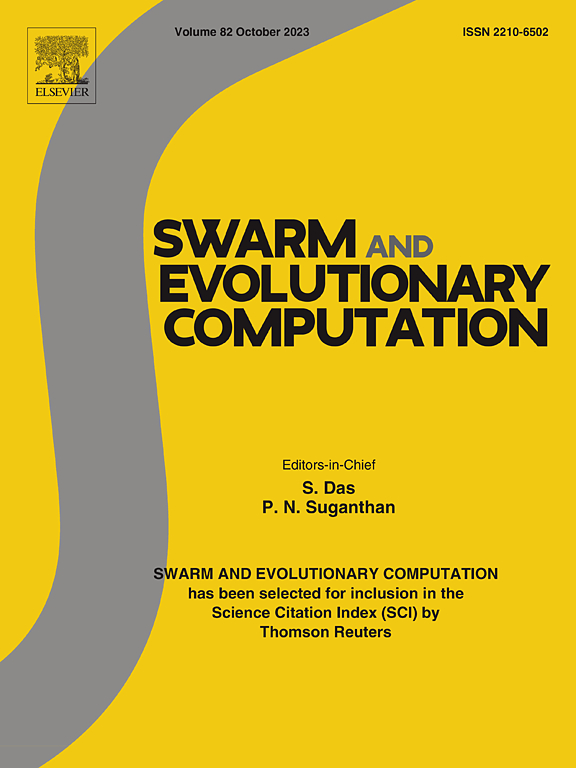Pruning for efficient DenseNet via surrogate-model-assisted genetic algorithm considering neural architecture search proxies
IF 8.2
1区 计算机科学
Q1 COMPUTER SCIENCE, ARTIFICIAL INTELLIGENCE
引用次数: 0
Abstract
Recently, convolution neural networks have achieved remarkable progress in computer vision. These neural networks have a large number of parameters, which should be limited in resource-constrained environments. To address this problem, new pruning approaches have explored using neural architecture search (NAS) to determine optimal subnetworks. We propose a novel pruning framework using a surrogate model-assisted genetic algorithm considering NAS proxies (SMA-GA-NP). We applied multi-dimensional encoding and designed crossover and mutation methods. To reduce the search time of NAS, we leveraged a surrogate model to approximate the fitness value of individuals and used NAS proxies, such as reducing the number of epochs and the training set size. The DenseNet-BC (k 12) model was used as the baseline. We achieved highly competitive performance on CIFAR-10 compared with other GA-based pruning methods and baselines. For CIFAR-100, we reduced the number of parameters by 11.25% to 18.75%, while achieving less than 1% performance degradation compared to the baseline model. These findings highlight SMA-GA-NP’s effectiveness in significantly reducing the number of parameters while having a negligible impact on the model’s performance. We also conducted an ablation study to explore the efficiency of the GA settings, the surrogate model, and NAS proxies in SMA-GA-NP and identified the current limitations and future potential of SMA-GA-NP.
考虑神经结构搜索代理的代理模型辅助遗传算法对高效DenseNet进行剪枝
近年来,卷积神经网络在计算机视觉领域取得了令人瞩目的进展。这些神经网络有大量的参数,在资源受限的环境下应该受到限制。为了解决这个问题,新的修剪方法已经探索使用神经结构搜索(NAS)来确定最佳子网络。我们提出了一个新的修剪框架,使用代理模型辅助遗传算法考虑NAS代理(SMA-GA-NP)。我们采用了多维编码,并设计了交叉和变异方法。为了减少NAS的搜索时间,我们利用代理模型来近似个体的适应度值,并使用NAS代理,例如减少epoch的数量和训练集的大小。以DenseNet-BC (k = 12)模型为基线。与其他基于ga的修剪方法和基线相比,我们在CIFAR-10上取得了极具竞争力的性能。对于CIFAR-100,我们将参数数量减少了11.25%到18.75%,而与基线模型相比,性能下降不到1%。这些发现突出了SMA-GA-NP在显著减少参数数量方面的有效性,同时对模型性能的影响可以忽略不计。我们还进行了消融研究,以探索SMA-GA-NP中GA设置、代理模型和NAS代理的效率,并确定SMA-GA-NP的当前局限性和未来潜力。
本文章由计算机程序翻译,如有差异,请以英文原文为准。
求助全文
约1分钟内获得全文
求助全文
来源期刊

Swarm and Evolutionary Computation
COMPUTER SCIENCE, ARTIFICIAL INTELLIGENCEC-COMPUTER SCIENCE, THEORY & METHODS
CiteScore
16.00
自引率
12.00%
发文量
169
期刊介绍:
Swarm and Evolutionary Computation is a pioneering peer-reviewed journal focused on the latest research and advancements in nature-inspired intelligent computation using swarm and evolutionary algorithms. It covers theoretical, experimental, and practical aspects of these paradigms and their hybrids, promoting interdisciplinary research. The journal prioritizes the publication of high-quality, original articles that push the boundaries of evolutionary computation and swarm intelligence. Additionally, it welcomes survey papers on current topics and novel applications. Topics of interest include but are not limited to: Genetic Algorithms, and Genetic Programming, Evolution Strategies, and Evolutionary Programming, Differential Evolution, Artificial Immune Systems, Particle Swarms, Ant Colony, Bacterial Foraging, Artificial Bees, Fireflies Algorithm, Harmony Search, Artificial Life, Digital Organisms, Estimation of Distribution Algorithms, Stochastic Diffusion Search, Quantum Computing, Nano Computing, Membrane Computing, Human-centric Computing, Hybridization of Algorithms, Memetic Computing, Autonomic Computing, Self-organizing systems, Combinatorial, Discrete, Binary, Constrained, Multi-objective, Multi-modal, Dynamic, and Large-scale Optimization.
 求助内容:
求助内容: 应助结果提醒方式:
应助结果提醒方式:


